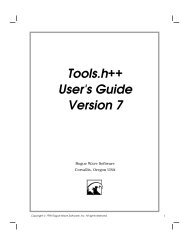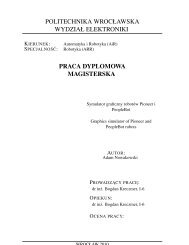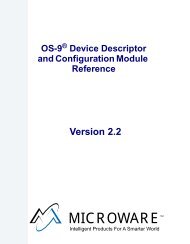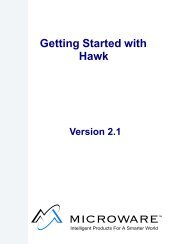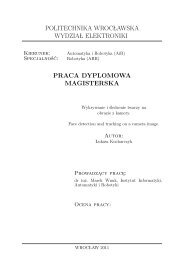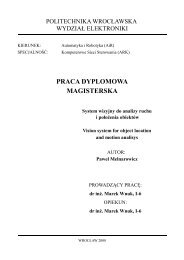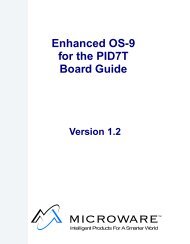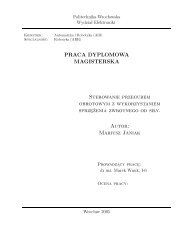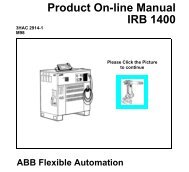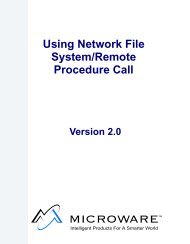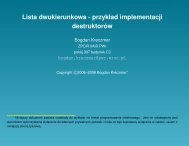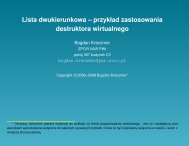AN3291 - Freescale Semiconductor
AN3291 - Freescale Semiconductor
AN3291 - Freescale Semiconductor
Create successful ePaper yourself
Turn your PDF publications into a flip-book with our unique Google optimized e-Paper software.
<strong>Freescale</strong> <strong>Semiconductor</strong>Application NoteDocument Number: <strong>AN3291</strong>Rev. 2, 04/2007How to Use IIC Module onM68HC08, HCS08, and HCS12MCUsby:Stanislav ArendarikApplication EngineerRoznov, Czech Republic1 IntroductionThis application note is an example of how to use the IICmodule on <strong>Freescale</strong>’s MCUs. The IIC module can beused in the master or slave mode, respectively. In thiscase, the master mode communicates with the serialEEPROM because the IIC bus is used mainly forcommunication between an MCU and a IIC peripheraldevice. The IIC bus can communicate directly betweentwo MCUs, but the SPI bus is better for this task.This application note summarizes the common IIC busstates and definitions and provides an example of how tocommunicate with serial EEPROMs (24C16 and24C512). You can easily use another IIC device insteadof an EEPROM, but you must change the IIC addressbyte that characterizes the slave device.Contents1 Introduction . . . . . . . . . . . . . . . . . . . . . . . . . . . . . . . . . . . 12 IIC Bus Summary . . . . . . . . . . . . . . . . . . . . . . . . . . . . . . 22.1 IIC Bus Terminology . . . . . . . . . . . . . . . . . . . . . . . 22.2 Bit Transfer . . . . . . . . . . . . . . . . . . . . . . . . . . . . . . 22.3 START and STOP Conditions . . . . . . . . . . . . . . . . 32.4 Bus Communication. . . . . . . . . . . . . . . . . . . . . . . . 32.5 Control Byte . . . . . . . . . . . . . . . . . . . . . . . . . . . . . . 32.6 Address Byte . . . . . . . . . . . . . . . . . . . . . . . . . . . . . 42.7 Acknowledge . . . . . . . . . . . . . . . . . . . . . . . . . . . . . 42.8 Read/Write Format . . . . . . . . . . . . . . . . . . . . . . . . 53 IIC Software Routines for MCUs . . . . . . . . . . . . . . . . . . . 53.1 Initialization of the IIC . . . . . . . . . . . . . . . . . . . . . . 63.2 Write Function . . . . . . . . . . . . . . . . . . . . . . . . . . . . 73.3 Read Function . . . . . . . . . . . . . . . . . . . . . . . . . . . . 93.4 Example with Interrupt Used . . . . . . . . . . . . . . . . 133.4.1 MCU as Master . . . . . . . . . . . . . . . . . . . . . 133.4.2 MCU as Slave . . . . . . . . . . . . . . . . . . . . . . 164 Conclusion. . . . . . . . . . . . . . . . . . . . . . . . . . . . . . . . . . . 17© <strong>Freescale</strong> <strong>Semiconductor</strong>, Inc., 2007. All rights reserved.
IIC Bus Summary2 IIC Bus SummaryThe IIC bus is a bidirectional, two-wire bus based on the wired AND (open drain) connection betweenmaster and slave devices. For proper functionality, pull-up resistors are used. Each transfer originates fromthe master device and is acknowledged or answered by the slave device.2.1 IIC Bus TerminologyThe following IIC bus terminology is used in this application note:• Transmitter — Device that sends data to the bus. A transmitter can put data on the bus of its ownaccord (master transmitter), or respond to a request for data from another device (slave transmitter).• Receiver — Device that receives data from the bus.• Master — Component that initializes a transfer, generates the clock signal, and terminates thetransfer. A master can be a transmitter or a receiver.• Slave — Device addressed by master. A slave can be a receiver or a transmitter.• Multi-master — Ability for more than one master to co-exist on the bus without collision or dataloss.• Arbitration — Prearranged procedure that authorizes only one master at a time to take control ofthe bus.• Synchronization — Prearranged procedure that synchronizes the clock signals provided by twoor more masters.• SDA — Data signal line (Serial DAta).• SCL — Clock signal line (Serial CLock).The SDA and SCL are bidirectional lines connected to a positive supply voltage via a current source orpull-up resistor. When the bus is free, both lines are high. Data on the IIC bus can transfer at rates up to100 kbit/s in standard mode, up to 400 kbit/s in fast mode or up to 3.4 Mbit/s in high-speed mode. Thenumber of devices connected to the bus depends on only the bus capacitance; the limit is 400 pF.2.2 Bit TransferThe data on the SDA line must be stable during the clock’s high period. The SDA line’s high or low statechanges only when the clock signal on the SCL line is low. See Figure 1.SDASCLData Line StableData ValidChangeof DataAllowedFigure 1. Bit TransferHow to Use IIC Module on M68HC08, HCS08, and HCS12 MCUs, Rev. 22<strong>Freescale</strong> <strong>Semiconductor</strong>
IIC Bus Summary2.3 START and STOP ConditionsWithin the IIC bus procedure, unique situations arise, which are defined as START and STOP conditions(see Figure 2). While the SCL line is high, a high-to-low transition on the SDA line is a START condition.While the SCL line is high, a low-to-high transition on the SDA line is a STOP condition. The masteralways generates the START and STOP conditions. The bus is free if the SDA and SCL lines remain at ahigh level after STOP and before START conditions.SDASCLSP2.4 Bus CommunicationFigure 2. START and STOP ConditionsThe bus transfer protocol is based on the byte transfers followed by an acknowledge bit (ACK). The bytetransfer starts with the most significant bit (MSB) to the least significant bit (LSB). The SCL positive clockimpulses clock each bit. The 9th SCL impulse clocks the ACK bit.Every bus transfer originates from a master device which sends the START condition to the bus. The thenext consecutive bytes’ sequence depends on the data being transferred through the IIC bus.2.5 Control ByteS = START ConditionP = STOP ConditionThe control byte always follows the START condition. The control byte selects and activates specificdevices on the bus; see Figure 3 for the control-byte structure. The first four bits represent the slavedevice’s control code. For example, the control byte for the serial EEPROM is A0 (control code is ‘1010’binary). The next three bits represent the chip selects of the connected EEPROMs on the bus. TheEEPROM uses these three bits for multiple device operations, but they are used as the higher bits of theinternal EEPROM address if the memory address byte is wider than 8 or 16 bits. This address depends onthe EEPROM capacity. For example, if the capacity is in the range of 16 kbits, these three bits representthe highest three bits of the address.The 8th bit is the R/W (read/write) bit. This bit determines the requested operation for the slave device:• If bit equals 0, this means a write operation• If bit equals 1, this means a read operation.The last 9th bit is the ACK bit and, in this case, always generated by the slave.How to Use IIC Module on M68HC08, HCS08, and HCS12 MCUs, Rev. 2<strong>Freescale</strong> <strong>Semiconductor</strong> 3
IIC Bus SummaryControl CodeAddress BitsS 1 0 1 0 A10 A9 A8 RWACKSlave AddressSTART BitRead/Write BitAcknowledge BitFigure 3. Control-Byte Structure2.6 Address ByteThe address byte brings the address information to the slave device. This byte determines the real addressin the EEPROM, to or from the data to be written or read. The address information structure depends onthe connected EEPROM capacity. The EEPROMs up to 16 kbits use one address byte, but EEPROMs withhigher capacity use two byte addresses (address H and address L). Address H is sent first. The structure ofaddress bytes for a one-byte address are in Figure 4, and in Figure 5 for two byte addresses. TheEEPROMs type 24C16 and 24C512 are used as communication devices.Bus ActivityMasterControlByteWordAddressDataByteSDASPBus ActivityACKACKACKFigure 4. One Byte Address IIC Write FormatBus ActivityMasterControlByteWordAddress HWordAddress LDataByteSDASPBus ActivityACKFigure 5. Two Byte Address IIC Write FormatACKACKACK2.7 AcknowledgeThe acknowledge bit (ACK) is the low-level impulse on the SDA line during the 9th pulse on the SCL line.The master always generates the SCL pulses. The receiver generates ACK pulses. This means in the writeoperation the slave device generates ACK after each byte transfers. In the read operation, the slavegenerates ACK when the control byte and address byte are sent from the master; the master generates ACKwhen it receives the data from the slave.How to Use IIC Module on M68HC08, HCS08, and HCS12 MCUs, Rev. 24<strong>Freescale</strong> <strong>Semiconductor</strong>
IIC Software Routines for MCUs2.8 Read/Write FormatThere are two types of data transfers on the IIC bus:• Read from the slave• Write to the slaveWhen the write operation executes, a data byte follows the address byte. This data byte contains the actualdata to be written to the address in the address byte; see Figure 4 and Figure 5.When the read operation executes in the first part of the communication protocol:1. The master writes the actual address to the slave.2. The master sends the repeat START condition to the bus, followed by the control byte with R/Wequal to 1.3. The slave device sends ACK and immediately sends the actual requested data.See Figure 6 for the read-operation structure.Bus ActivityMasterControlByteWordAddressControlByteDataByteSDAS0 S1PBus ActivityACKACKFigure 6. Read-Operation StructureACKNOACKSee Figure 4, Figure 5, and Figure 6 for read- and write-byte operations. The second style of data transferis page-write and page-read. For more information on these styles refer to the slave-device data sheet.3 IIC Software Routines for MCUsDetailed descriptions of all IIC modules can be found in the MCU data sheet. A short review follows:• Address register — Used differently in the HC908 than in the S08 and S12 MCU types. In theHC908 core, the address register’s content is sent automatically after the START condition, and thedata register content follows the condition. This address register also serves as its own IIC-slaveaddress in slave mode. In the S08 and S12 core, the address register is active only in the slave modeand comprises its own IIC slave address of the MCU on the bus. This can be used by themulti-MCU connection on the bus.• Frequency divider register — Determines the SCL clock speed. The bus frequency acts as thesource frequency for the IIC module.• Control register — Controls all IIC module functionality.• Status register — Comprises the information about the actual bus state.• Data register — Serves as the input and output point for all information transferred through thebus.How to Use IIC Module on M68HC08, HCS08, and HCS12 MCUs, Rev. 2<strong>Freescale</strong> <strong>Semiconductor</strong> 5
IIC Software Routines for MCUs3.1 Initialization of the IICThe main task is to set the right speed of the SCL clock signal. These clocks are based on the bus frequency.The next task is to set the IIC module functionality — to use or not use the interrupt service routine,activate the IIC module, and set the slave mode. Refer to Example 1, Example 2, and Example 3.Example 1. Software for HC908 MCU (MC68HC908AP64 Used)void init_I2C (void){MMCR1_MMEN = 1; // Enable IIC;MMCR1_MMCLRBB = 1; // Clear bus busy flag;MMCR1_MMTXAK = 1;MMCR2_MMRW = 0; // R/W bit = 0;MMCR2_MMAST = 0; // Slave mode actually;MMCR2_MMNAKIF = 0;MMCR2_MMALIF = 0; // Clear flags;MMSR = 0;// Clear all flags (Status register);MMFDR = 3;// Set speed to 25kHz for Bus = 4MHz;}Example 2. Software for 9S12 MCU (MC9S12DP256B Used)void Init_I2C(void){IBFD = 0x4C;IBAD = 0x00;IBCR = 0x80;}// frequency divider register: Bus = 8MHz => SCL = 91kHz;// slave address of this module;// enable I2C module and No interrupts;void Init_I2C (void){IIC1C_IIC1EN = 1;IIC1C_TXAK = 1;IIC1C_MST = 0;IIC1F = 0x99;IIC1S_SRW = 0; // R/W bit = 0;}Example 3. Software for the 9S08 MCU (MC9S08GB60 Used)// Enable I2C;// not generate ACK by master after transfer;// Slave mode actually;// Set speed to 50kHz for Bus = 18.8743MHz;// 12.5k->0x39; 50k->0x99; 100k->0x59;How to Use IIC Module on M68HC08, HCS08, and HCS12 MCUs, Rev. 26<strong>Freescale</strong> <strong>Semiconductor</strong>
3.2 Write FunctionIIC Software Routines for MCUsThe write to slave at an address will be discussed first. To maintain this task, activate communication withthe slave by sending the START bit followed by the slave-address byte. These bits’ content are discussedin Section 2.6, “Address Byte.” When the master sends the byte, the slave sends the ACK bit during the9th SCL impulse. The slave must acknowledge each byte the master sends.The next byte (second byte) is the internal address of the memory array. This address can be one or twobytes, depending on memory size. The slave must acknowledge each byte the master sends.The third (fourth for large memory) is the data byte — this data will write to a specified address. The slaveACK follows this data byte. When the master receives this ACK bit, it generates the STOP bit. At thismoment, the slave internally disconnects from the IIC bus and internally processes the write operation.While the slave processes the requested operation (write) it cannot answer the next master request.Therefore, the master must wait for the amount of time defined in the slave-device data sheet, or it mustperiodically send requests to the slave and test for the right answer (ACK from the slave).Example 4. Write Byte for HC908 MCU (MC68HC908AP64 and 24C16 Used)void I2C_write_byte (byte addr, byte wr_data){MMCR2_MMRW = 0;// Set Write mode;MMADR = own_sl_addr;// set combined address of Slave for write;MMDTR = addr;// set address of Slave to read;//-------start of transmit bytes to IIC bus-----MMCR2_MMAST = 1; // Start transfer - Master bit = 1;while (!(MMSR_MMTXBE)); // wait till data transferred;while (MMSR_MMRXAK);// wait for ACK from slave;//-----Slave ACK occurred------------MMDTR = wr_data;// write data byte into EEPROM;while (!(MMSR_MMTXBE)); // wait till data transferred;MMDTR = 0xFF;// generate SCL impulse for slave to send ACK bit;while (MMSR_MMRXAK);// wait for ACK from slave;MMCR2_MMAST = 0;// STOP bit;}Example 6 and Example 7 are for a larger type of EEPROM (24C512). The word address is divided intotwo parts (two bytes): low byte and high byte, as defined in Example 5.How to Use IIC Module on M68HC08, HCS08, and HCS12 MCUs, Rev. 2<strong>Freescale</strong> <strong>Semiconductor</strong> 7
IIC Software Routines for MCUstypedef union{word EE_Address;struct{byte Address_H;byte Address_L;}Bytes;}tAddr;tAddr sADDR;#define Address sADDR.EE_Address#define Addr_L sADDR.Bytes.Address_L#define Addr_H sADDR.Bytes.Address_HExample 5. Word Address Divided into Low Byte and High ByteExample 6. Write Byte for 9S08 MCU (MC9S08GB60 and 24C16 Used)void IIC_write_byte(word addr, byte data){Address = addr;// load address;temp = (Addr_H & 0x07)
IIC Software Routines for MCUswhile (!IIC0_IBSR_IBIF); // wait until IBIF;IIC0_IBSR_IBIF=1;// clear the interrupt event flag;while(IIC0_IBSR_RXAK); // check for RXAK;//-----Slave ACK occurred------------IIC0_IBDR = Addr_H; // Send high byte of the word address;while (!IIC0_IBSR_IBIF); // wait until IBIF;IIC0_IBSR_IBIF=1;// clear the interrupt event flag;while(IIC0_IBSR_RXAK); // check for RXAK;//-----Slave ACK occurred------------IIC0_IBDR = Addr_L; // Send low byte of the word address;while (!IIC0_IBSR_IBIF); // wait until IBIF;IIC0_IBSR_IBIF=1;// clear the interrupt event flag;while(IIC0_IBSR_RXAK); // check for RXAK;//-----Slave ACK occurred------------IIC0_IBDR = data;while (!IIC0_IBSR_IBIF); // wait until IBIF;IIC0_IBSR_IBIF=1;// clear the interrupt event flag;while(IIC0_IBSR_RXAK); // check for RXAK;//-----Slave ACK occurred------------IIC0_IBCR_MS_SL = 0; // generate STOP condition;}3.3 Read FunctionThe read function is similar to the write function. First, write the address (byte or word) into the slave. AnACK bit from the slave always follows these write cycles. When the address properly writes to the slave,the master generates the REPEAT START condition. Then, the master again sends the control byte but withthe R/W bit equal to 1. This means the read-from-slave function. The ACK bit from the slave follows thisbyte. The master must then switch to receive mode and perform the read data from the IIC-data register(IICDR) function. This instruction generates the SCL pulses for the slave to send data from the requestedaddress.There are two possible options:• If the master does not need the next data byte from the slave, it sends the NOACK (ACK = 1) andthe STOP condition.• If the master wants to read the next data byte from the slave, it generates the ACK bit (ACK = 0).The slave recognizes this ACK bit and moves the internal address pointer to the next address. Then, themaster performs the read data from the IICDR function to generate the next series of SCL pulses for theslave to send data. This sequence can perform infinitely.Example 8. Read Byte for HC908 Family (HC908AP64 Used)byte I2C_read_byte (byte addr)//output is byte "rd_data";{MMCR2_MMRW = 0;// Set Write mode;MMADR = own_sl_addr; // set combined address of Slave for write;MMDTR = addr;// set address;//-------start of transmit first byte to IIC bus-----MMCR2_MMAST = 1; // Start transfer - Master bit = 1;while (!(MMSR_MMTXBE)); // wait till data transferred;while (MMSR_MMRXAK); // wait for ACK from slave;How to Use IIC Module on M68HC08, HCS08, and HCS12 MCUs, Rev. 2<strong>Freescale</strong> <strong>Semiconductor</strong> 9
IIC Software Routines for MCUs}//-----Slave ACK occurred------------MMCR2_MMRW = 1;// set read operation;MMCR1_REPSEN = 1;// enable repeat Start bit;MMCR1_MMTXAK = 0;// Master will generate ACK;MMCR2_MMAST = 1; // Start transfer - Master bit = 1;//------start of transmit Repeat start & "A1" to IIC bus-------MMDTR = 0xFF;// send repeated start and combined address;while (!(MMSR_MMTXBE)); // wait till data transferred;while (MMSR_MMRXAK); // wait for ACK from slave;MMDTR = 0xFF;// send SCL clocks for the slave to send data;MMCR1_MMTXAK = 1;// Disable master ACK after read byte from Slave;while (!(MMSR_MMRXBF)); // wait till data received;rd_data = MMDRR;// read received data;MMCR2_MMAST = 0;// generate STOP bit - End of transfer;return rd_data;Example 9 and Example 10 are for a larger type of the EEPROM (24C512). The word address is dividedinto two parts (two bytes): low byte and high byte (see Example 5).typedef union{word EE_Address;struct{byte Address_H;byte Address_L;}Bytes;}tAddr;tAddr ADDR;Example 9. Read Byte for 9S08 Family (MC9S08GB60 and 24C16 Used)#define Address ADDR.EE_Address#define Addr_L ADDR.Bytes.Address_L#define Addr_H ADDR.Bytes.Address_Hbyte IIC_read_byte(word addr){Address = addr;temp = (Addr_H & 0x07)
IIC Software Routines for MCUs}IIC1S_IICIF=1;// clear the interrupt event flag;while (IIC1S_RXAK); // check for RXAK;//-----Slave ACK occurred------------IIC1C_TX = 0;// set up to receive;IIC1C_TXAK = 1;// acknowledge disable;RD_data = IIC1D;// dummy read;while (!IIC1S_IICIF); // wait until IBIF;IIC1S_IICIF=1;// clear the interrupt event flag;IIC1C_MST = 0;// generate stop signal;RD_data = IIC1D;// read right data;return RD_data;typedef union{word EE_Address;struct{byte Address_H;byte Address_L;}Bytes;}tAddr;tAddr ADDR;Example 10. Read Byte for 9S12 Family (MC9S12DT512 and 24C512 Used)#define Address ADDR.EE_Address#define Addr_L ADDR.Bytes.Address_L#define Addr_H ADDR.Bytes.Address_Hvoid IIC_read_byte(word addr){Address = addr;IIC0_IBCR_TXAK = 0; // TXAK = 0;IIC0_IBCR |= 0x30; // RX/TX = 1; MS/SL = 1; TXAK = 0;// And generate START condition;IIC0_IBDR = slavewrite; // Address the slave and set up for master transmit;while (!IIC0_IBSR_IBIF); // wait until IBIF;IIC0_IBSR_IBIF=1;// clear the interrupt event flag;while(IIC0_IBSR_RXAK); // check for RXAK;//-----Slave ACK occurred------------IIC0_IBDR = Addr_H;// Send high byte of word address;while (!IIC0_IBSR_IBIF); // wait until IBIF;IIC0_IBSR_IBIF=1;// clear the interrupt event flag;while(IIC0_IBSR_RXAK); // check for RXAK;//-----Slave ACK occurred------------IIC0_IBDR = Addr_L;// Send low byte of word address;while (!IIC0_IBSR_IBIF); // wait until IBIF;IIC0_IBSR_IBIF=1;// clear the interrupt event flag;while(IIC0_IBSR_RXAK); // check for RXAK;//-----Slave ACK occurred------------IIC0_IBCR_RSTA = 1;// set up repeated start;IIC0_IBDR = slaveread; // (slave_address) | (RW = 1);while (!IIC0_IBSR_IBIF); // wait until IBIF;IIC0_IBSR_IBIF=1;// clear the interrupt event flag;while (IIC0_IBSR_RXAK); // check for RXAK;How to Use IIC Module on M68HC08, HCS08, and HCS12 MCUs, Rev. 2<strong>Freescale</strong> <strong>Semiconductor</strong> 11
IIC Software Routines for MCUs}//-----Slave ACK occurred------------IIC0_IBCR_TX_RX = 0; // set up to receive;IIC0_IBCR_TXAK = 1; // acknowledge disable;RD_data = IIC0_IBDR; // dummy read;while (!IIC0_IBSR_IBIF); // wait until IBIF;IIC0_IBSR_IBIF=1;// clear the interrupt event flag;IIC0_IBCR_MS_SL = 0; // generate stop signal;RD_data = IIC0_IBDR; // read right data;Example 11 gives a routine for 9S12 MCU core and 24C512 EEPROM block-write and block-readfunctions.Example 11. Block-Write / Block-Read for 9S12 Core and 24C512 EEPROM (MC9s12XDT512 Used)void IIC_write_block(word addr, byte len){byte page;Address = addr;// load address;page = len;// load length of data pack to be written;if(page > MAX_PAGE) page = MAX_PAGE; // set limit;IIC0_IBCR_TXAK = 0; // TXAK = 0;IIC0_IBCR |= 0x30; // RX/TX = 1; MS/SL = 1; TXAK = 0;// And generate START condition;IIC0_IBDR = slavewrite; // Address the slave and set up for master transmit;while (!IIC0_IBSR_IBIF); // wait until IBIF;IIC0_IBSR_IBIF=1;// clear the interrupt event flag;while(IIC0_IBSR_RXAK); // check for RXAK;IIC0_IBDR = Addr_H;// Send high byte of word address;while (!IIC0_IBSR_IBIF); // wait until IBIF;IIC0_IBSR_IBIF=1;// clear the interrupt event flag;while(IIC0_IBSR_RXAK); // check for RXAK;IIC0_IBDR = Addr_L;// Send low byte of word address;while (!IIC0_IBSR_IBIF); // wait until IBIF;IIC0_IBSR_IBIF=1;// clear the interrupt event flag;while(IIC0_IBSR_RXAK); // check for RXAK;for(i=0;i MAX_LENGTH) length = MAX_LENGTH;IIC0_IBCR_TXAK = 0; // TXAK = 0;IIC0_IBCR |= 0x30; // RX/TX = 1; MS/SL = 1;// And generate START condition;How to Use IIC Module on M68HC08, HCS08, and HCS12 MCUs, Rev. 212<strong>Freescale</strong> <strong>Semiconductor</strong>
IIC Software Routines for MCUsIIC0_IBDR = slavewrite; // Address the slave and set up for master transmit;while (!IIC0_IBSR_IBIF); // wait until IBIF;IIC0_IBSR_IBIF=1;// clear the interrupt event flag;while(IIC0_IBSR_RXAK); // check for RXAK;IIC0_IBDR = Addr_H; // Send high byte of word address;while (!IIC0_IBSR_IBIF); // wait until IBIF;IIC0_IBSR_IBIF=1;// clear the interrupt event flag;while(IIC0_IBSR_RXAK); // check for RXAK;IIC0_IBDR = Addr_L; // Send low byte of word address;while (!IIC0_IBSR_IBIF); // wait until IBIF;IIC0_IBSR_IBIF=1;// clear the interrupt event flag;while(IIC0_IBSR_RXAK); // check for RXAK;IIC0_IBCR_RSTA = 1; // set up repeated start;IIC0_IBDR = slaveread;while (!IIC0_IBSR_IBIF); // wait until IBIF;IIC0_IBSR_IBIF=1;// clear the interrupt event flag;while (IIC0_IBSR_RXAK); // check for RXAK;IIC0_IBCR_TX_RX = 0; // set up to receive;dummy = IIC0_IBDR;// dummy read;for(i=0;i SCL = 400kHz;IICA = 0; // slave address of this module;IICS = 0x12; // clear the IBAL and IICIF flags;IICC = 0xC0; // enable IIC module with interrupt;How to Use IIC Module on M68HC08, HCS08, and HCS12 MCUs, Rev. 2<strong>Freescale</strong> <strong>Semiconductor</strong> 13
IIC Software Routines for MCUs}Example 13 shows the Read_block and Write_block functions for the serial EEPROM 24AA256 and theMC9S08QG8 MCU in the main loop:Example 13. Read_block and Write_block Functions (24AA256 EEPROM and MC9S08QG8 Used)void IIC_read_block(word addr,byte len){Address = addr;length = len;i = 0;// for interrupt only;IIC_Res_flg = 0; // for interrupt only;flag = 10;// defines receive function in the interrupt service routine;if(length > MAX_LENGTH) length = MAX_LENGTH;IICC_TXAK = 0; // RX/TX = 1; MS/SL = 1, TXAK = 0;IICC |= 0x30;// And generate START condition;IICD = IIC_SLAVE; // Address the slave and set up for master transmit;}void IIC_write_block(word addr, byte len){Address = addr;// load address;length = len;// load length of data pack to be written;i = 0;// for interrupt only;IIC_Res_flg = 0; // for interrupt only;flag = 2;// defines transmit function in the interrupt service routine;if(length > MAX_PAGE) length = MAX_PAGE; // set limit;IICC_TXAK = 0; // RX/TX = 1; MS/SL = 1; TXAK = 0;IICC |= 0x30;// And generate START condition;IICD = IIC_SLAVE; // Address the slave and set up for master transmit;}The flag variable is byte variable used in the IIC interrupt service routine to recognize which byte ofcommunication protocol is processed.Example 14 shows the read function from the serial EEPROM (24LC16B) and the MCU (S12DP256B) inthe main loop.Example 14. EEPROM (24LC16B) and MCU (S12DP256B) in Main Loopvoid i2c_read_byte(unsigned char read_addr){flag = 0;temp = read_addr;IBCR_MS_SL = 1; // Set transmit and master mode;IBCR_TX_RX = 1; // And generate start condition;IBDR = slave_IIC_addr;}How to Use IIC Module on M68HC08, HCS08, and HCS12 MCUs, Rev. 214<strong>Freescale</strong> <strong>Semiconductor</strong>
IIC Software Routines for MCUsThe temp variable is a common byte variable; the flag variable is used in the IIC interrupt service routineto recognize which communication-protocol byte is processed. Then, the interrupt-service-routine codewould be as shown in Example 15.Example 15. Interrupt-Service-Routine Code for MC9S08QG8 and 24C512 EEPROM__interrupt void isrViic(void){IICS_IICIF = 1;switch(flag){case 2:{IICD = Addr_H;flag++;return;}case 3:{IICD = Addr_L;flag++;return;}case 4:{if(length){IICD = WR_Data[i];length--;i++;return;}else{IICC_MST = 0;flag = 0;IIC_Res_flg = IIC_OK;return;}}case 10:{IICD = Addr_H;flag++;return;}case 11:{IICD = Addr_L;flag++;return;}case 12:{IICC_RSTA = 1;IICD = IIC_SLAVE | 1;// clear the interrupt event flag;// TX mode;// Send high byte of word address;// TX mode;// Send low byte of word address;// TX mode;// generate stop signal;// END of write cycle;// Send high byte of word address;// Send low byte of word address;// set up repeated start;How to Use IIC Module on M68HC08, HCS08, and HCS12 MCUs, Rev. 2<strong>Freescale</strong> <strong>Semiconductor</strong> 15
IIC Software Routines for MCUs}}flag++;return;}case 13:{IICC_TX = 0;dummy = IICD;flag++;return;}case 14:{if(length > 1){RD_Data[i] = IICD;length--;i++;return;}else if(length == 1){IICC_TXAK = 1;RD_Data[i] = IICD;i++;flag++;return;}}case 15:{}IICC_MST = 0;//RD_Data[i] = IICD;flag = 0;IIC_Res_flg = IIC_OK;return;// set up to receive;// dummy read;// save data to RAM;// acknowledge disable;// save data to RAM;// generate stop signal;// save data to RAM;3.4.2 MCU as SlaveThis routine is used when the MCU is presented as a slave device on the IIC bus. The MCU needs to catchall IIC bytes intended for it. The recognition of the valid bytes is based on the match of its own slaveaddress saved in the IBAD register. If the master sends an address to the IIC bus, the slave generates anIIC interrupt when this address matches its own slave address in the IBAD register. Then, for example, theslave saves all bytes from the IIC bus to a RAM buffer and processes them later.Example 16 shows the slave MCU (S12DP256B) connected to a master MCU of the same type (twoEVBS12DP256B boards connected together).The variables defined are:byte RD_data[20];byte i2c_cnt, temp;How to Use IIC Module on M68HC08, HCS08, and HCS12 MCUs, Rev. 216<strong>Freescale</strong> <strong>Semiconductor</strong>
ConclusionExample 16. Slave-Initialization Routinevoid Init_IIC(void){IBFD = 0x2B; // frequency divider register: Bus = 8MHz => SCL = 91kHz;IBAD = My_IIC_addr; // slave address of this module;IBCR = 0xC0; // enable IIC module and interrupts, RX mode, Slave mode, ACK = 0;IBSR_IBAL = 1; // clear the IBAL flag;}Example 17. Interrupt-Service Routine__interrupt void I2C_ISR(void){if(IBSR_IAAS){IBCR_TX_RX = IBSR_SRW; // set Rx/Tx mode in accordance to received calling address byteand clear the IAAS bit;IBSR = IBSR_IBIF_MASK; // clear the flag;temp = IBDR;// dummy read to initiate the read data byte;}i2c_cnt = 0;// clear the received data counter;}else{IBSR = IBSR_IBIF_MASK; // clear the flag;RD_data[i2c_cnt] = IBDR; // save received data to data buffer;i2c_cnt++;}4 ConclusionThis application note explains using the IIC module in <strong>Freescale</strong>’s HC908, 9S08, and 9S12 family MCUs.The user routines are tested on the mentioned MCUs and boards. The serial EEPROMs are often used asIIC devices and serve as good examples. If you need to use something other than an IIC device (forexample, a real-time clock [RTC]), change the device address (0xD0 for RTC, 0xA0 for EEPROM) andmanage the right byte sequence, as described in the appropriate data sheet.How to Use IIC Module on M68HC08, HCS08, and HCS12 MCUs, Rev. 2<strong>Freescale</strong> <strong>Semiconductor</strong> 17
How to Reach Us:Home Page:www.freescale.comE-mail:support@freescale.comUSA/Europe or Locations Not Listed:<strong>Freescale</strong> <strong>Semiconductor</strong>Technical Information Center, CH3701300 N. Alma School RoadChandler, Arizona 85224+1-800-521-6274 or +1-480-768-2130support@freescale.comEurope, Middle East, and Africa:<strong>Freescale</strong> Halbleiter Deutschland GmbHTechnical Information CenterSchatzbogen 781829 Muenchen, Germany+44 1296 380 456 (English)+46 8 52200080 (English)+49 89 92103 559 (German)+33 1 69 35 48 48 (French)support@freescale.comJapan:<strong>Freescale</strong> <strong>Semiconductor</strong> Japan Ltd.HeadquartersARCO Tower 15F1-8-1, Shimo-Meguro, Meguro-ku,Tokyo 153-0064Japan0120 191014 or +81 3 5437 9125support.japan@freescale.comAsia/Pacific:<strong>Freescale</strong> <strong>Semiconductor</strong> Hong Kong Ltd.Technical Information Center2 Dai King StreetTai Po Industrial EstateTai Po, N.T., Hong Kong+800 2666 8080support.asia@freescale.comFor Literature Requests Only:<strong>Freescale</strong> <strong>Semiconductor</strong> Literature Distribution CenterP.O. Box 5405Denver, Colorado 802171-800-441-2447 or 303-675-2140Fax: 303-675-2150LDCFor<strong>Freescale</strong><strong>Semiconductor</strong>@hibbertgroup.comInformation in this document is provided solely to enable system and softwareimplementers to use <strong>Freescale</strong> <strong>Semiconductor</strong> products. There are no express orimplied copyright licenses granted hereunder to design or fabricate any integratedcircuits or integrated circuits based on the information in this document.<strong>Freescale</strong> <strong>Semiconductor</strong> reserves the right to make changes without further notice toany products herein. <strong>Freescale</strong> <strong>Semiconductor</strong> makes no warranty, representation orguarantee regarding the suitability of its products for any particular purpose, nor does<strong>Freescale</strong> <strong>Semiconductor</strong> assume any liability arising out of the application or use of anyproduct or circuit, and specifically disclaims any and all liability, including withoutlimitation consequential or incidental damages. “Typical” parameters that may beprovided in <strong>Freescale</strong> <strong>Semiconductor</strong> data sheets and/or specifications can and do varyin different applications and actual performance may vary over time. All operatingparameters, including “Typicals”, must be validated for each customer application bycustomer’s technical experts. <strong>Freescale</strong> <strong>Semiconductor</strong> does not convey any licenseunder its patent rights nor the rights of others. <strong>Freescale</strong> <strong>Semiconductor</strong> products arenot designed, intended, or authorized for use as components in systems intended forsurgical implant into the body, or other applications intended to support or sustain life,or for any other application in which the failure of the <strong>Freescale</strong> <strong>Semiconductor</strong> productcould create a situation where personal injury or death may occur. Should Buyerpurchase or use <strong>Freescale</strong> <strong>Semiconductor</strong> products for any such unintended orunauthorized application, Buyer shall indemnify and hold <strong>Freescale</strong> <strong>Semiconductor</strong> andits officers, employees, subsidiaries, affiliates, and distributors harmless against allclaims, costs, damages, and expenses, and reasonable attorney fees arising out of,directly or indirectly, any claim of personal injury or death associated with suchunintended or unauthorized use, even if such claim alleges that <strong>Freescale</strong><strong>Semiconductor</strong> was negligent regarding the design or manufacture of the part.<strong>Freescale</strong> and the <strong>Freescale</strong> logo are trademarks of <strong>Freescale</strong> <strong>Semiconductor</strong>, Inc.All other product or service names are the property of their respective owners.© <strong>Freescale</strong> <strong>Semiconductor</strong>, Inc. 2007. All rights reserved.RoHS-compliant and/or Pb-free versions of <strong>Freescale</strong> products have the functionalityand electrical characteristics as their non-RoHS-compliant and/or non-Pb-freecounterparts. For further information, see http://www.freescale.com or contact your<strong>Freescale</strong> sales representative.For information on <strong>Freescale</strong>’s Environmental Products program, go tohttp://www.freescale.com/epp.Document Number: <strong>AN3291</strong>Rev. 204/2007


